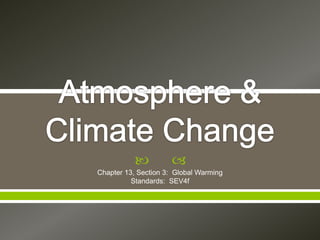
Unit 5 b ch 13 s3 global warming
- 1. Chapter 13, Section 3: Global Warming Standards: SEV4f
- 2. Solar radiation passes through the atmosphere and warms Earth’s surface. Energy is absorbed by Earth surface & some re-radiated to space. Greenhouse gases trap some heat near Earth’s surface. o Water vapor* o Carbon dioxide* o Methane o CFCs o Nitrous oxide Water vapor & CO2 store most heat. Earth would be too cold to live on if we did not have the greenhouse effect.
- 3. Carbon dioxide (CO2) o Burning fossil fuels & deforestation Chlorofluorocarbons (CFCs) o Refrigerants, Styrofoam, propellants Methane (CH4) o Animal waste, biomass burning, fossil fuels, landfills, livestock, rice paddies, sewage, wetlands Nitrous oxide- N20 o Biomass burning, deforestation, microbes in soil Water Vapor (H20) o Evaporation, plant respiration (transpiration)
- 4. Mauna Loa Observatory in Hawaii used to measure CO2 levels to infer a global concentration. Discovered two things: o CO2 levels vary by season • Winter- levels higher due to decay releasing CO2 from dead leaves. • Summer – levels are lower b/c plants are alive & removing CO2 for photosynthesis o CO2 levels have increased Keeling curve created by Charles Keeling who discovered the change in CO2 levels during seasons.
- 5. As greenhouse gas concentrations increase, the temperature on the planet increases. Predictions about future growth of gases & temperature are done with computer modeling o Enter data such as CO2 levels, wind, temperature of oceans, etc into computer equations that predict future based on changes in any of these variables.
- 6. 1. Changes in global weather patterns 2. Human health problems 3. Agricultural impacts 4. Changes in plant & animal behavior 5. Rising sea levels
- 7. 1. Changes in global weather patterns o As ocean heats up, hurricanes & typhoons will become more common o Cause changes in ocean currents, which cause changes in weather. • Ex: Places that are wet become dry
- 8. 2. Human Health Problems o Hotter in cities o Longer pollen season- affecting people with seasonal allergies o Disease carrying insects may expand their ranges if it stays warmer longer in places that were previously too cold for them.
- 9. 3. Agricultural Impacts o Crop yield may decrease if climate changes o As droughts increase, the demand for irrigation water increases putting more stress on already depleted aquifers.
- 10. 4. Changes in plant & animal behavior o As cold habitats warm, different plants may invade & grow, altering the diversity of the habitat. o Bird migrations may change o Some animals will wake up from hibernation earlier and go back into hibernation later… how would this affect their food supply? o Coral reefs rely on algae- if algae die due to increased ocean temperature coral reefs die- called coral bleaching.
- 11. 5. Rising sea levels o Ice sheets, glaciers, & snow in Greenland & Antarctica are melting o Coastal communities most affected • Saltwater will contaminate coastal aquifers • Homes may be washed away • Estuaries & wetlands are nurseries for many animals. Offspring may not be as tolerant to increased salt
- 15. Positive Feedback Loop As CO2 increases, the atmosphere warms. This warms the oceans and the oceans take up less CO2. This means more CO2 stays in the air and the cycle starts all over again. Ex: Albedo Effect Albedo- reflectivity of a surface Ice reflects heat. Water absorbs heat. As we lose ice, less heat gets reflected and more heat gets absorbed and ice melts even more. See the next series of slides and notice the size of the ice pack and the arrows that show reflection & absorption.
- 16. Albedo Effect
- 20. IPCC- Intergovernmental Panel on Climate Change 2500 of the world’s leading climatologists from 70 countries Released report on changes in global climate: o Global surface temp have increased by 0.6C during 20th century o Snow & ice extent have decreased o Average global sea level has risen o Greenhouse gas increase is due to human activity
- 21. 1997- 160 countries came together to discuss reducing greenhouse gas emissions. Created Kyoto Protocol o Requires developed countries to decrease emissions of CO2 and other greenhouse gases by 5% below their 1990 levels by 2012. o When 55% of the attending nations ratify this treaty it will go into effect. o Currently US and China (the biggest greenhouse gas emitters) have not signed. • US did not sign b/c there were no mandates in place for developing countries (like China) • US felt like China was an emerging powerhouse and should be subject to the same standards as developed countries. Kyoto Protocol News - The New York Times
- 22. Explain why Earth’s atmosphere is like the glass in a greenhouse. Explain why carbon dioxide in the atmosphere is increasing. Explain one theory for why Earth’s climate is becoming warmer. Name some of the possible consequences of a warmer Earth.